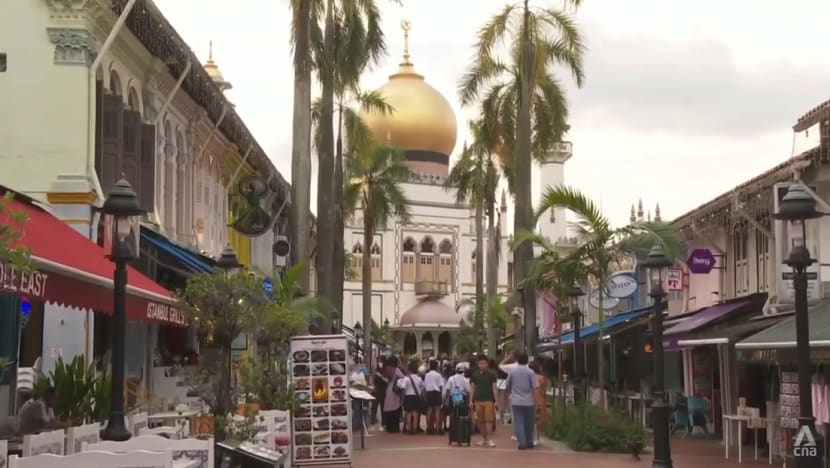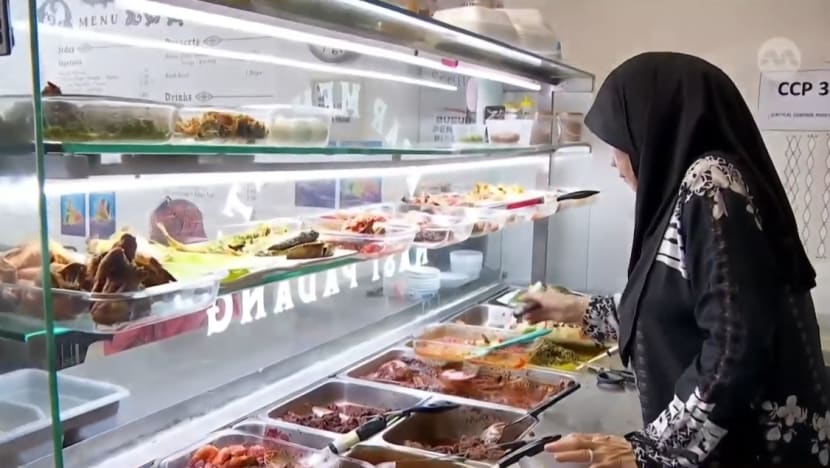Kampong Gelam heritage trades affected by rising rental and waning interest among Singapore’s youth
Some of these small businesses have adapted in creative ways in order to survive.

Visitors to Kampong Gelam and the historic Sultan Mosque.
SINGAPORE: Heritage shops in the Kampong Gelam area have seen an impact on their trades amid an increasingly challenging business environment.
They cite rising rental prices, difficulty in attracting new customers, and a struggle in bringing in younger people as concerns that may put an end to their trades.
To survive, some of these small businesses have adapted in creative ways.
TEACHING THE YOUNGER GENERATION
For instance, kebaya maker Ratianah Tahir, has chosen to safeguard the tricks of her trade by imparting them to young enthusiasts.
The 52-year-old, who has honed her art for decades, has mentored about 10 students on the intricacies of designing and making the traditional garment in the past few years.

Only 20 per cent of them have gone on to start their own kebaya businesses, she told CNA.
The owner of Kebaya by Ratianah said she is worried that not many will turn this skill into a business, and the trade will fade away despite her best efforts.
“People think this is glamorous work, but actually it is not. There is a lot of work behind the scenes, a lot of trial and error with the garment. It tests your patience and endurance. Many encounter a mistake and just give up,” she said.
“So, sadly, (not many continue with the craft) as there are a lot of challenges and things to learn. It takes passion, determination, time and courage.”

RISING RENTAL PRICES
Apart from difficulties in teaching their craft to the younger generation, heritage trades are also finding it hard to stay afloat due to rising rents.
Mdm Ratianah has had to find ways to attract new shoppers, such as putting a modern spin on kebayas – a move which has significantly increased her young customer base.
“Back in the 40s and 50s, all the ladies in Singapore donned kebayas, it didn’t matter what race they were. I think we have forgotten about the kebaya. I would like to bring back the romance of the kebaya to the new generations,” she said.
Her shop has integrated modern twists to the traditional fashion, such as making them easier to wear by incorporating zippers or press buttons, and patterns such as polka dots and cat prints.
But even targeting new customers has not helped offset the pressure for some of her neighbours, including nasi padang restaurant Sabar Menanti.
One of the oldest such eateries in Kampong Gelam, the shop has been serving up hot plates of steamed rice with a variety of authentic dishes from West Sumatra since the 1920s.
However, it will be moving out of its current location along North Bridge Road later this month, after the landlord told the restaurant in June that its rent will doubled to about S$17,000 per month.

“Kampong Gelam is a very popular area right now. There are a lot of foreigners coming here and owning shophouses. I think the rental rates are pegged to the price of the property that they purchase,” said Mr Iszahar Tambunan, the third generation owner of the eatery.
“I've seen a lot of businesses in Kampong Gelam closing after a year or two because, while they tried (hard), at the end of day, the rent affects the business.”
He said his century-old traditional food stall will be relocating to another space nearby with a lower rent.
Mr Iszahar also finds it difficult to employ young talent, and has had to turn to hiring some employees from overseas.
“The younger generation right now, they have a lot of options of the kind of restaurant establishment that they wish to join,” he said.
“Nasi Padang is very labour intensive. We start at five in the morning and we have 25 dishes to prepare. Even I have not mastered all the dishes, but I’m trying to pick up the skills from my mum.”
However, when it comes to customers, the restaurant has tasted success in attracting younger diners.
Like many other businesses in the area exploring innovative ways to appeal to more patrons, Mr Iszahar has turned to social media to expand the reach of his eatery, which traditionally served mostly Malay-Muslim diners.
“After we did a bit of revamping and started being more aggressive on social media, we do see more people coming in from other races, enjoying our food, foreigners as well. It's very nice to see the younger crowd coming into a very old establishment to enjoy real food,” he said.
WHY ARE RENTS SO HIGH?
Real estate firm ERA Singapore said the rising rental prices could be due to more foreigners investing in shophouses as they do not need to pay additional buyer's stamp duties (ABSD), which they would be subjected to on residential properties.
The doubling of the ABSD for foreigners to 60 per cent in April made it substantially more expensive to purchase a residential property, hence diverting the demand to shophouses.

One Kampong Gelam, a community organisation, said the increasing rental is not unique to businesses there. It is working with government agencies to find ways to help struggling firms.
“When we speak to businesss here, it's sad to see that whatever they are making, they all go back to the rent. This is the reality and it really is not a good thing to hear,” said Mr Zaki Maarof, chairman of the organisation.
“It has to strike a balance where they can also have some reserves for future spending. We hope government agencies try to find a way. We want to facilitate all these shops, especially the cultural businesses here.”
He added that heritage trades need extra help as they are harder to sustain. Customers do not tend to purchase these goods, such as traditional clothings, as often as food and beverages.
Some trades have vanished in the area in modern times, and Mr Zaki hopes to bring them back one day. Some examples are makers of songkok – traditional headgear primarily worn by Malay men, and chappal – a kind of leather sandal.
“Those who make kueh, as well as artists and music, these all fall under vanishing trades. These are things we want to preserve or bring back. We want Kampong Gelam to be a place where people not just come to find food, it’s also a place of (tradition) and beauty.”
The neighbourhood, one of Singapore’s oldest urban quarters, is also planning events and activities that create buzz in order to bring in the crowds.




















